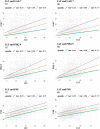Internet Addiction, Symptoms of Anxiety, Depressive Symptoms, Stress Among Higher Education Students During the COVID-19 Pandemic
- PMID: 35774570
- PMCID: PMC9237380
- DOI: 10.3389/fpubh.2022.893845
Internet Addiction, Symptoms of Anxiety, Depressive Symptoms, Stress Among Higher Education Students During the COVID-19 Pandemic
Abstract
Poor mental health is a growing concern among young people during the coronavirus disease 2019 (COVID-19) pandemic. The aim of this study was to assess the associations of Internet addiction with depressive symptoms, anxiety symptoms, and stress in higher education students during the COVID-19 pandemic, as well as to examine these mental health problems in the context of study-related characteristics. The research sample consisted of 3,099 participants from the Czech Republic (CZ: 1,422) and Slovak Republic (SK: 1,677). The Internet Addiction Test (IAT), the Generalized Anxiety Disorder (GAD-7) scale, the Patient Health Questionnaire for depressive symptoms (PHQ-9), and the Perceived Stress Scale (PSS) were used to measure mental health problems. The analyses also included demographic data (gender and age) and study-related characteristics (form of study, degree of study, field of study, distance between college and home, and housing during the semester). Based on the results of frequency and descriptive analyses, the prevalence of mental health problems was high. The most serious levels of Internet addiction (IAT cut-off point ≥ 50), to which attention should be paid, were found in 3.5% of Czech and 6.2% of Slovak students. Using the standard cut-off point of GAD-7 ≥ 10, 14.1% of Czech and 11.6% of Slovak students were identified with anxiety symptoms. Regarding the PHQ-9 with the cut-off point ≥ 10, 23.4% of Czech and 19.1% of Slovak students had depressive symptoms, which should be addressed. Using the PSS cut-off point ≥ 27, 12.9% of Czech students and 9.1% of Slovak students perceived high stress. The quantile regression analysis showed that Internet addiction was positively associated with anxiety symptoms, depressive symptoms, and stress in all of the analyzed cases (p-value < 0.001). In terms of study-related characteristics, the binomial logistic regression analysis revealed that risk factors for mental health problems in Czech and Slovak students were mainly full-time form of study and living away from home during the semester. Internet addiction, anxiety symptoms, depressive symptoms, and stress are issues that require increased attention, and professionals and policy-makers should implement interventions to effectively prevent and help students with psychological problems.
Keywords: GAD-7; IAT; PHQ-9; PSS; college; mental health problems; young people.
Copyright © 2022 Gavurova, Khouri, Ivankova, Rigelsky and Mudarri.
Conflict of interest statement
The authors declare that the research was conducted in the absence of any commercial or financial relationships that could be construed as a potential conflict of interest.
Figures
Similar articles
-
Internet Addiction in Socio-Demographic, Academic, and Psychological Profile of College Students During the COVID-19 Pandemic in the Czech Republic and Slovakia.Front Public Health. 2022 Jun 23;10:944085. doi: 10.3389/fpubh.2022.944085. eCollection 2022. Front Public Health. 2022. PMID: 35812472 Free PMC article.
-
Somatic Symptoms, Anxiety, and Depression Among College Students in the Czech Republic and Slovakia: A Cross-Sectional Study.Front Public Health. 2022 Mar 11;10:859107. doi: 10.3389/fpubh.2022.859107. eCollection 2022. Front Public Health. 2022. PMID: 35359763 Free PMC article.
-
Comorbid anxiety and depressive symptoms and the related factors among international medical students in China during COVID-19 pandemic: a cross-sectional study.BMC Psychiatry. 2023 Mar 14;23(1):165. doi: 10.1186/s12888-023-04638-7. BMC Psychiatry. 2023. PMID: 36918819 Free PMC article.
-
Anxiety and Depression Disorders in Undergraduate Medical Students During the COVID-19 Pandemic: An Integrative Literature Review.Int J Environ Res Public Health. 2024 Dec 3;21(12):1620. doi: 10.3390/ijerph21121620. Int J Environ Res Public Health. 2024. PMID: 39767461 Free PMC article. Review.
-
Global prevalence of internet addiction among university students: a systematic review and meta-analysis.Curr Opin Psychiatry. 2025 May 1;38(3):182-199. doi: 10.1097/YCO.0000000000000994. Epub 2025 Feb 13. Curr Opin Psychiatry. 2025. PMID: 40009750
Cited by
-
Depression, anxiety, and burnout in academia: topic modeling of PubMed abstracts.Front Res Metr Anal. 2023 Nov 27;8:1271385. doi: 10.3389/frma.2023.1271385. eCollection 2023. Front Res Metr Anal. 2023. PMID: 38090103 Free PMC article.
-
Problematic Internet Use among Polish Students: Prevalence, Relationship to Sociodemographic Data and Internet Usage Patterns.Int J Environ Res Public Health. 2023 Jan 30;20(3):2434. doi: 10.3390/ijerph20032434. Int J Environ Res Public Health. 2023. PMID: 36767799 Free PMC article.
-
Sugar-sweetened beverage consumption and depressive symptoms among college students in northeastern China: The mediating role of mobile phone use addiction.Prev Med Rep. 2025 Jun 2;55:103123. doi: 10.1016/j.pmedr.2025.103123. eCollection 2025 Jul. Prev Med Rep. 2025. PMID: 40529599 Free PMC article.
-
Assessing Physiological and Psychological Factors Contributing to Stress among Medical Students: Implications for Health.Int J Environ Res Public Health. 2022 Dec 15;19(24):16822. doi: 10.3390/ijerph192416822. Int J Environ Res Public Health. 2022. PMID: 36554703 Free PMC article.
-
Mental health and academic experiences among U.S. college students during the COVID-19 pandemic.Front Psychol. 2023 Apr 27;14:1166960. doi: 10.3389/fpsyg.2023.1166960. eCollection 2023. Front Psychol. 2023. PMID: 37187557 Free PMC article.
References
-
- Islam S, Akter R, Sikder T, Griffiths MD. Prevalence and factors associated with depression and anxiety among first-year university students in bangladesh: a cross-sectional study. Int J Ment Health Addict. (2020). 10.1007/s11469-020-00242-y - DOI
-
- Schofield MJ, O'Halloran P, McLean SA, Forrester-Knauss C, Paxton SJ. Depressive symptoms among Australian university students: who is at risk? Aust Psychol. (2016) 51:135–44. 10.1111/ap.12129 - DOI
Publication types
MeSH terms
LinkOut - more resources
Full Text Sources
Medical



